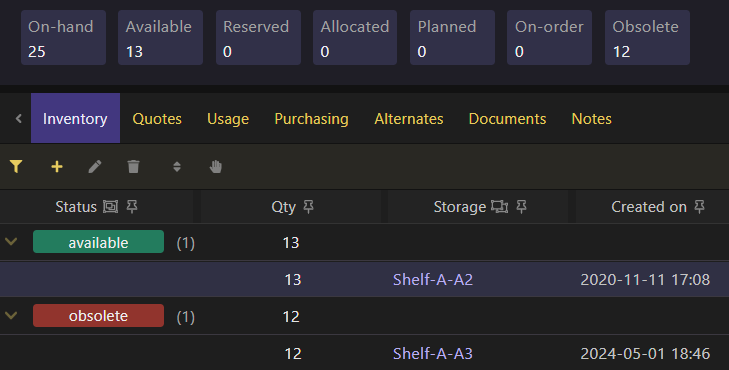New feature: Internal Part Number generator. Internal part numbers can now be automatically generated. The part number consists of a simple counter: every time a new part number is generated, the counter is incremented. You can also define multiple Series. Each Series keeps its own counter and add a prefix to the generated part number. If enabled, internal part numbers are generated whenever manually creating parts, bulk importing parts, or creating parts through the API.

New feature: Obsolete Inventory. You can now change the status of available inventory, from available to obsolete (and vice-versa). The status can be changed by simply editing selected inventory (right-click andEdit inventory...). Obsolete inventory is inventory that's no longer usable or but which you still want to keep track of. Obsolete inventory is ignored for all purposes other than tracking it and for calculating a part'sWorth.

- Defining depth when importing tree-structured data (e.g. Storage and Labels): a setting was added under
Settings - General - Importwhich allows to define a character that should be used to denote depth. This way you can have names that include a dash-, the character previously used (and still used by default) to denote depth in tree-structured data. - When adding parts and quantities into a purchase order from a purchase list, the unit of measure used in the purchase order will match the one from the selected quote. For example: if a purchase list indicates 150 screws to be purchased and you selected a quote with pricing for a "Box-of-100", you'd need to buy 2 "Box-of-100", being that quantity and unit of measure the ones to be listed in the purchase order.
- When splitting items with Designators on a production build, the designators can now be edited both on the source and destination so they are also correctly split.
- Unit cost on generic parts is now the weighted average of all its alternates by taking into account their stock on-hand. Before, the unit cost of a generic part was the simple average of the unit cost of its alternates.
- A pick-list can now be generated from a production build by right-clicking on the table and select
Pick List.... This list is grouped by storage location, so you can more conveniently check all the parts and quantities that need to be picked for each storage location - Custom fields of type
Optioncan now be displayed on the calendar (for the data types that support the calendar) - New setting
Custom are preferredadded underSettings - Quotes: when enabled, all custom suppliers are considered preferred so they don't have to be listed under the preferred suppliers setting - "Remove if empty" setting under
Settings - Parts - Inventory: inventory is automatically removed only if it's not associated with a Lot - API: labels can now be created, updated and deleted
- Part Usage: the
Revfor the part being used is displayed on the table asRev (Part)whereas theRev (Product)refers to the revision of the product/BOM the part is being used on - Part Usage: context-menu
Replace part...added, so the part being used on selected BOMs can be replaced with some other part - Initial setup time reduced at the expense of having some tables taking a bit longer to load the first time they are rendered.